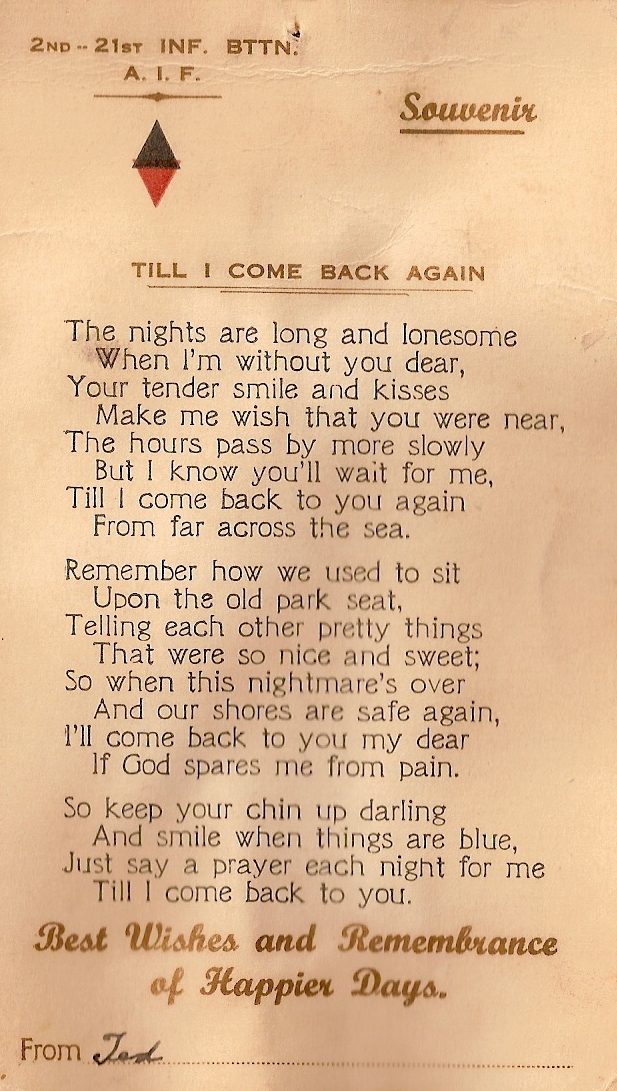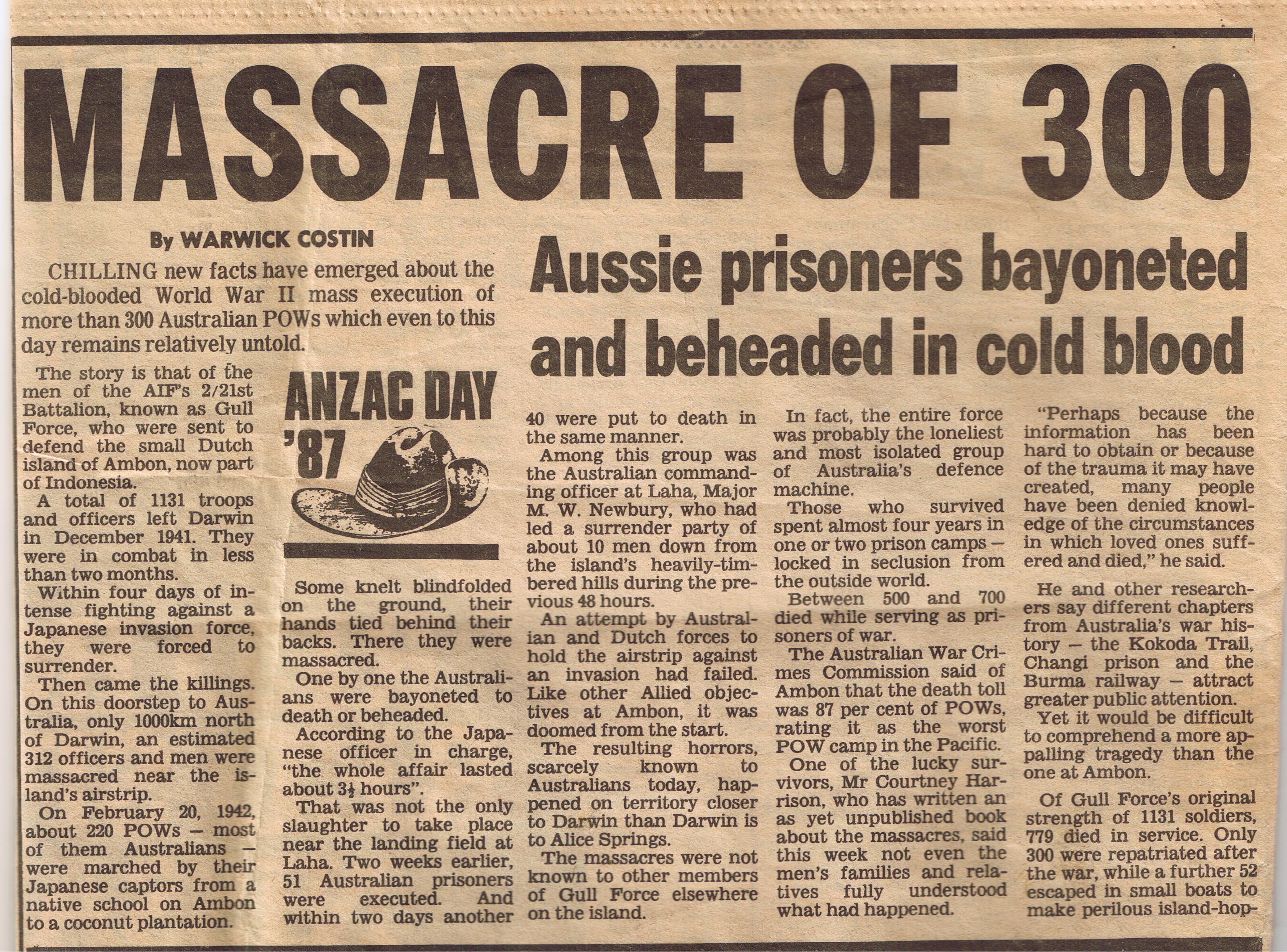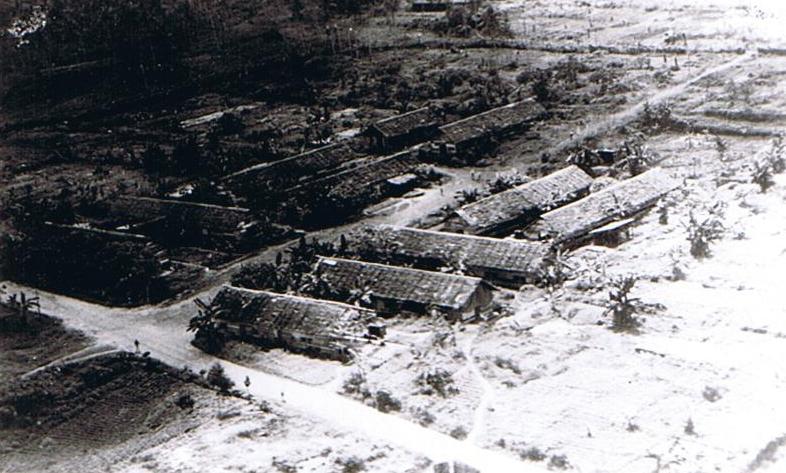On the night of 30/31 January 1942 Japanese forces landed on Ambon. The Japanese were resisted by Australian troops at a number of locations, including Mount Nona, Kudamati, Amahusu and Laha.
Laha airfield was defended by about 300 Australian troops. Aside from a small number who escaped, there were no survivors. After the surrender at Laha, Japanese personnel carried out mass executions of the Australian soldiers. A group of RAAF men were also executed at Laha. Roger Maynard has written of the executions “History would record it as one of the worst massacres of the Second World War”.
After the surrender of the main part of Gull Force on 3 February 1942, the troops were imprisoned in their former barracks on Ambon.
The horrific story of this massacre relates to the men from Gull Force - the 2/21st Batallion formed in central Victoria in 1940. The 2/22nd Batallion, Lark Force, is mentioned in an article we will feature in the coming days.

Gull Force was sent to Ambon ( part of modern day Indonesia ) to defend the strategic island's harbour and airstrip. When an overwhelmingly larger Japanese force of approximately 20.000, landed on the Island in January 1942 Gull Force numbered 1131 men, most of them Victorians.

Those that survived went on to spend three and a half years completely cut off from the rest of the world, and endured starvation, beatings, executions, and acts of brutality, which have been described as being amongst one of the worst chapters of the Pacific War. Only a third of the soldiers lived to return home.

Aerial photograph of P.O.W. Prison Camp taken c. April 1945
Of the original 1131 men of Gull Force, only 363 were to survive the battles and the years of captivity at the hands of the Japanese.
Courtney Harrison, a survivor of the camp recalled his time in captivity in an interview:
" We used to get the rats and we used to get them, down where the kitchen was, they had a few drains coming out of there, covered-in drains, and we’d go down there of a night and pour boiling water down and catch the rats as they come out, we’d bang ‘em, and catch them, and eat them, and we soon got rid of those, there were, didn’t have too many of those; snakes, and that we, big snakes, we waited for three weeks for a snake, about eight foot long come out of a tree! And we got him, and chopped him up for the soup! Things like that, snails, and all that sort of thing we were eating, anything that’s not poisonous you can eat, you see, it doesn’t matter what it is, as long as it’s not poisonous. "
This is a full length feature movie nearly two hours long.
Gull Force Statistical Summary
Killed in Action (estimated) ........................ 54
Massacred at Laha ................................... 229
Executed in POW camps ........................... 17
Killed in bombings ................................... 13
Killed in Chinese ambush on Hainan .......... 9
Died as prisoners on Ambon ...................... 378
Died as prisoners on Hainan ..................... 66
Missing on Hainan ................................... 10
Died after liberation ................................. 3
TOTAL DEATHS ...... 779
Repatriated to Australia from Hainan ......... 181
Repatriated to Australia from Ambon .......... 119
Total escapes from Ambon ....................... 52
ORIGINAL STRENGTH OF GULL FORCE ... 1131
As one person said
" My Dad was a prisoner of war on Ambon for 3 years and 11 months. The Laha executions were beyond comprehension to me when I was first told of it. I cannot imagine how these prisoners survived the cruelty of the Japanese.
Surely it is time to get back the fighting spirit and start to get back to what we were and who we were. Because I am seriously concerned about how rapidly we have descended into a world of fear where we are seemingly digging our own graves and begging our captors to kill us, send us to camps and so many of us are thanking them for doing it.

Australian prisoners of war (POWs) after their release from Ambon following the Japanese surrender, relaxing on deck reading newspapers aboard HMAS Glenelg en route to Morotai. AWM 019307.
sources for this article include:
http://www.sevensoldiersons.com.au/
https://www.gullforce.org.au/index.html
https://cv.vic.gov.au/stories/a-diverse-state/geelong-voices/ambon-island-of-mist/
My sincere gratitude to the authors of the above articles who helped in my compilation of this short but heartfelt tribute to the men and boys of Gull Force.

